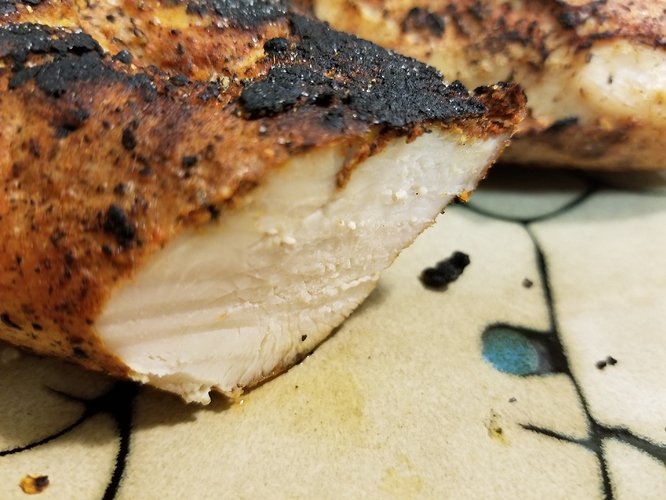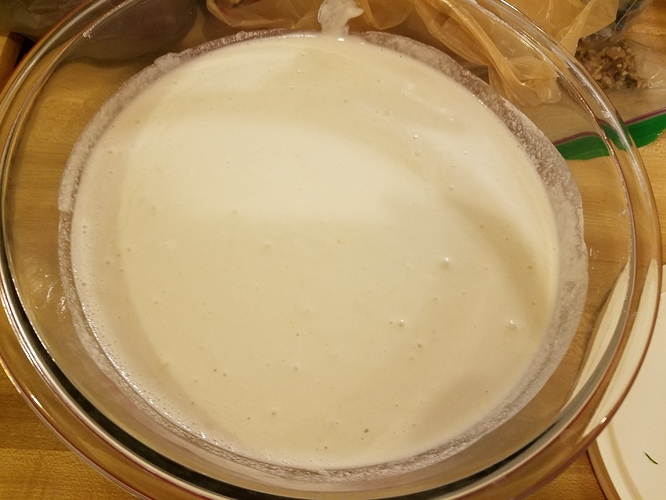Having another one of those meals where I’m having a hard time believing it’s diet food. Chicken breasts stuffed with cream cheese / garlic / spinach / bacon. And steamed broccoli with cheddar on top. :D
The real test of diet food is if you lose weight on your plan. I think we have a weight loss thread somewhere here, let us know how it’s going.
It’s a chicken day for sure!
Sous vide at 143, coated with the Ethiopian Berebere spice that @Timex mentioned, then seared in a skillet. Not sure if I should have washed all the rub off, as that blackened a bit. But man is it tasty.
The plan is to use that on three items this week, a salad for my lunch, some pasta, and some basmati rice with some roasted veggies.
At that temp it came out done, still juicy but just beginning to go to the stringy stage, you can see that more at the bottom of the cut.
Not gonna lie; I have never made tamales in my life. I was always very intimidated by them, but my mom has recently been sharing some stories about the ones her family maid used to make back in the day in Guatemala, and so we are gonna try to get together and make some together sometime soon :)
Tonight was Night 1 of a South Indian-inspired menu.
First, I prepped a big batch of dosa/idly/uttapam batter:
Soak 1 part skinned urad dal (black lentils) and 3 parts medium grain “idly” rice, plus a little bit of “poha” (flattened rice) and some fenugreek seeds in enough water to cover by a couple of inches for 3-4 hours–soak the lentils separate from the rest.
Then, using a high-powered blender or a mixer-grinder, blend down first the lentils (with enough water to form a thick, fluffy paste), then the rice mixture (into a thinner, smooth paste with very little remaining grainy-ness), and combine the two. Let rest someplace warm for 8-12 hours to ferment. The results. . . tomorrow :)
I also made some tadka dal:
In a stovetop pressure cooker, add oil, with cumin seeds, then diced red onion, a couple of cloves of minced garlic, and a couple of diced chilies. Cook till the onions are softened and taking on color, then add in a mixture of red chili powder, turmeric, coriander and cumin powders, and salt, then a couple of chopped roma tomatoes. Then in goes 4 cups of water + 1 cup of rinsed toor dal–split yellow lentils–and on goes the lid. Bring up to pressure and cook for 4-5 minutes, then uncover and stir in some cilantro, garam masala, and a tadka. That’ll be a tablespoon or two of hot oil to which you add first mustard seeds, then hing powder (asafoetida), curry leaves, and dried red chilies; once it’s all sizzly, dump into the curry.
It’s a tasty supper, served over a little rice.
Oh, and breakfast this morning was nice :-D
I’d suggest doing it a little lower. I use 60 C (ie 140F).
My girlfriend has made them about twice a year every year since she was pretty young. It’s day affair that she says is somewhat worth it. All I know is that there is a fine line between making everything correctly, and opening up your steamer to find masa and meat filling soup.
You’d have the meat part or the filling part down without any problem. It’s the making of the masa, filling the husks and steaming everything that is a pain. And it takes a while. I can ask her, but most likely she does it as she does all of her cooking, by look and feel, and only a vague recipe floating in her head somewhere.
All of that said, she’s also a fan of canned tamales and churching them up in a baking dish with some homemade salsa. My palette isn’t good enough to know the difference except for the fact they are smaller than when she makes them.
Great tip, I’m slowly doing that over time. I’ve cooked them at 150 to see what Kenji describes as stringy, then slowly lowering the temp a bit each time. I’ve also upped the time a bit, going around two hours at temp. I’ll drop to 140 next time and report results. :)
Jesus. I’m like what, two hours away? Is there any of that left?
My diet plans are sad to say: no.
And yeah, the whole, “Woops you did one thing wrong and made stew instead of tamales” aspect of, well, making tamales, is certainly a big part of my fears!
I’ve been really lax on posting photos. These aren’t exactly my best, but…
Taco…Monday? All day long black beans, sous vide chicken breast, cheese, Cholulu hot sauce, guac on corn tortilla. Just finished eating these (thinking of going back for more!)
Caramelized Onion + moz/ricotta pizza. Happy with the rise on the crust (i’m slowly getting better at stretching out the dough by hand to get it thin enough so it rises well.)
I made some really tasty eggplant parm following this recipe, but the picture is too ugly to post. It’s a healthy version of the dish where you don’t bread/fry the eggplant.
I’m glad you guys like your Sous Vide and I’m not going thread crap any more than this one post but…
Ergh! That’s like literally colder than the temperature on my water heater. If you were Sous Viding at 160F… maybe.
These tacos are fucking gorgeous. May I please come over?
Sure. Drop by, I’ve got extras of everything. :)
Since we’re pasting links around, I’m going to quote some stuff for you from here. Ginger Yellow already put this link up, but…might as well quote the ever living shit out of the relevant section.
Here’s the thing: Industry standards for food safety are primarily designed to be simple to understand, usually at the expense of accuracy. The rules are set up such that anybody, from the turn-and-burner at Applebee’s to the fry-dunker at McDonald’s, can grasp them, ensuring safety across the board. But for single-celled organisms, bacteria are surprisingly complex, and despite what any ServSafe chart might have you believe, they refuse to be categorized into a step function. The upshot is: Food safety is a function of both temperature and time.
As you can see, at 165°F, you achieve pasteurization nearly instantly. It’s the bacterial equivalent of shoving a stick of dynamite into an anthill. At 136°F, on the other hand, it takes a little over an hour for the bacteria to slowly wither to death in the heat. In fact, you can even pasteurize chicken as low as just above 130°F, but I don’t recommend it. Partly because there’s a risk that your sous-vide device is mis-calibrated by a degree or two, but, more importantly, because chicken cooked to 130°F has a very soft, almost raw texture that is simply not appealing.
It’s important to note that these times represent the minimum safe cooking time for chicken after it has reached those temperatures internally, which can take up to 45 minutes or so. To be safe, I recommend tacking on an extra hour to the time recommended in the government charts when starting with chicken from the fridge, or two hours when starting with
frozen chicken.
Ah, excellent! And the GoodEats linked back to a USDA document. Ok! More convinced it’s possible to pasteurize with Sous Vide now. It is worth remembering that table linked is not total cooking time but time when internal temperature has reached the safety threshold.
You eat all your steaks well done?
Rare is too rare for me - the texture of rare meat i find disgusting. I don’t mind medium but i start to get wary if “medium-rare” has been ordered, since some restaurants aren’t sufficiently skilled to distinguish between rare and medium-rare. OTOH, i tend to cook burgers mostly all the way through, as that’s what’s been recommended we do and i also like the taste of a nicely cooked charcoaled burger.
I agree. I don’t like it when meat has what I call a “gummy” texture. But the beauty of a technique like sous-vide is that it gives you great control to cook things just how you want with no guessing. but there’s a whole world of awesome between rare and 160 degrees.
For burgers, you should cook them to well done for safety reasons, unless cooking for a long time (like I did the other day). Ground beef, unless you or your butcher ground it, has to be cooked differently than a whole cut, because the risk of bacterial contamination is higher. Next time we do burgers, we are going to up the temp just a few degrees.
One thing I’ve found is that I like sous vide steaks more rare than I would normally order a steak, I think. A lot of it is, as you say, a lot of places don’t know how to do it… also, around Pittsburgh, they make steaks way TOO rare (like, literally cold inside).
But you can make a rare steak sous vide, and it ends up being dark pink all the way through… still pink though, not red. It still tastes like cooked meat instead of raw meat.
I actually agree with you completely there. While I like med rare, I only order it in places that I know have consistently cooked to temp before. New places or less high end, I order med. I share your distaste for rare.








